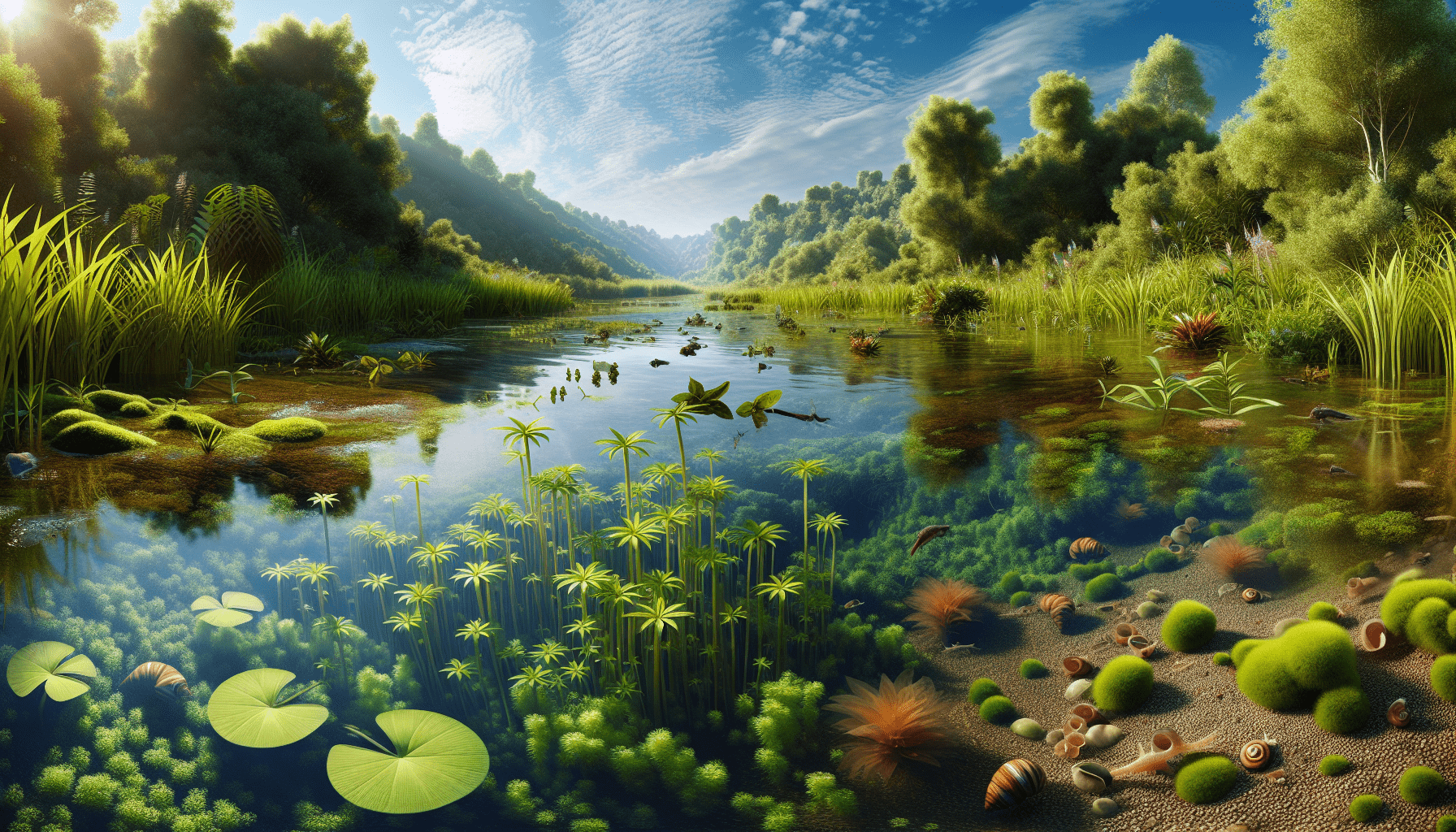In the expansive realm of flora that inhabit our water bodies, the aquatic weed Callitriche Terrestris occupies a significant niche. By casting your gaze upon this article, you are setting forth to grasp the general characteristics, growth patterns, environmental impacts, and possible control measures for this particular species. As we journey through, you will consolidate your understanding of this weed and its interactions with its surrounding ecology. Recognizing Callitriches Terrestris and understanding its behavioral patterns could bolster your comprehension of freshwater ecosystems while also enriching your knowledge of aquatic biology.

General Description of Callitriche Terrestris
Callitriche Terrestris, commonly known as terrestrial water-starwort, is a small aquatic or semiaquatic perennial herbaceous plant belonging to the family Plantaginaceae. This plant is largely known for its aquatic weed-like features that allow it to grow and thrive in various water settings. As a species of the Callitriche genus, it is antipodal in its distribution, existing in both the Southern and Northern Hemispheres.
How Callitriche Terrestris looks
Callitriche Terrestris emanates a distinct green facade with delicate and slender stems that may reach up to 20-70 cm in length. From these stems grow opposite pairs of leaves, usually lanceolate to ovate in shape. The plant encompasses both submerged and floating leaves, each demonstrating a different shape. The submerged leaves are narrow and elongated, while the floating leaves are broader and more egg-shaped.
Color and size of Callitriche Terrestris
Callitriche Terrestris sports in its leaves a rich green hue, giving it a vibrant appearance, especially when thriving in clear water systems. The yellow-green flowers, which appear from spring through summer, are small and relatively inconspicuous. The plant generally attains a height of a few centimeters; however, longitudinally it can stretch out to about a meter, primarily when it grows in water and floats on the surface.
Distinctive features of Callitriche Terrestris
Among its significant characteristics, the submerged and emergent leaves’ disparity is of particular interest. The emergent leaves are broader, while the submerged are narrow and elongated, providing the plant with a two-fold morphology. Another distinctive feature is its minute, axillary flowers which are barely noticeable, often overlooked. The plant also demonstrates a phenomenon known as amphibious dichotomy, which allows it to efficiently adapt between terrestrial and aquatic environments.
Habitats of Callitriche Terrestris
Callitriche Terrestris, given its versatile nature, can adapt to an array of habitats ranging from freshwater to saline environments provided that the necessary growing conditions are met.
Freshwater environments suitable for Callitriche Terrestris
Callitriche Terrestris primarily thrives in freshwater environments such as ponds, canals, and slow-moving rivers. It shows a particular predilection for clear, shallow waters with adequate sunlight. They are usually found growing luxuriantly on the underwater surfaces or floating on surface waters in such settings.
Saline environments for Callitriche Terrestris
Not limited to freshwater habitats, Callitriche Terrestris can also tolerate environments with moderate salinity which includes marshes, salt pans, and brackish waters. Although they might demonstrate diminished growth rates in such saline conditions, their adaptability has marked them as a halophytic plant group.
Preferred climate and geography of Callitriche Terrestris
This resilient plant species demonstrates a wide geographical distribution, often found in areas of fluctuating temperatures from tropical to temperate regions. They tend to prefer sunny, open areas and are more typically found flourishing in zones near coastlines or along riverbanks.
Growth and Development of Callitriche Terrestris
Studying the life cycle of Callitriche Terrestris provides valuable insights into its germination and maturation process, its lifespan, and changes in growth patterns as per the seasons.
Germination and maturation process
The germination of Callitriche Terrestris starts underwater when the seed starts taking up water, causing enzymatic actions that reinvigorate it into an active, growing plant. The maturation process is reliant on the surrounding temperatures and the availability of sunlight and nutrients, factors that have a direct effect on the rate and efficacy of growth.
Life span of Callitriche Terrestris
The maximum lifespan of a Callitriche Terrestris plant, from germination to demise, would encompass a duration of several years; however, the inherent life stages show significant fluctuations depending upon environmental factors and seasonal changes.
Seasonal growth patterns
Notably, Callitriche Terrestris displays notable changes in growth as per the seasons, with growth peaking during the spring and summer months due to increased sunlight. During the colder months, the plant’s growth slows, and it may even partially retreat into the sediment.
Nutrient Requirements of Callitriche Terrestris
Going beyond the commonly known components that are water, sunlight, and carbon dioxide, plants have multiple nutrient requirements for proper growth and development.
Necessary macronutrients
Macronutrients such as nitrogen, phosphorous and potassium play a crucial role in the growth and development of Callitriche Terrestris, contributing to processes such as photosynthesis, root development and resistance to diseases.
Trace minerals needed by Callitriche Terrestris
Apart from major nutrients, trace minerals such as iron, zinc, copper, and manganese are also pertinent for the normal growth of this aquatic plant. These nutrients are typically absorbed from the soil or water in which the plant is growing.
Effect of nutrient availability on growth
The availability or lack of these nutrients greatly affects the growth rate and overall health of a Callitriche Terrestris plant. Deficiency may lead to stunted growth, yellowing leaves and reduced vitality, whereas a surplus might yield luxuriant growth but also instigate the probability of it becoming an invasive species.

Adaptive Features of Callitriche Terrestris
Well-adapted to its environment, Callitriche Terrestris possesses several adaptive traits that allow it to survive and flourish in both water-laden and water-deficient conditions.
Adaptive features for water conservation
In terms of adapting to variances in water availability, Callitriche Terrestris employs a two-pronged leaf morphology to absorb water efficiently, featuring submerged and emergent leaves. Furthermore, in cases of extreme water scarcity, the plant can survive as a terrestrial plant, focusing growth on its broader, emergent leaves.
Survival strategy in nutrient-deprived environments
Ever so resilient, Callitriche Terrestris can tolerate nutrient-deficient environments by slowing down its growth and conserving resources for essential functions. It also has the ability to absorb nutrients directly from water, allowing it to survive in environments where soil nutrients are scarce.
Adaptations for propagation and seed dispersal
Callitriche Terrestris produces copious amounts of seeds with a coating that aids flotation, facilitating dispersal via water currents. This adaptation not only assists with propagation but also allows the plant to extend its geographical range and adapt to new environments.
Callitriche Terrestris as Aquatic Weed
Despite their ecological benefits, an unregulated growth of Callitriche Terrestris can give rise to numerous problems, leading to their classification as an aquatic weed.
Invasiveness of Callitriche Terrestris
A single Callitriche Terrestris plant can generate thousands of seeds each season, which, coupled with its hardiness and ability to flourish in various environments, raises the risk of it becoming invasive. This can lead to it dominating a water body within a short period of time.
Impact on aquatic systems
Despite being beneficial to some organisms, excessively thriving Callitriche Terrestris can choke water bodies, impeding sunlight penetration and altering the habitats’ oxygen levels. This can disrupt the balance of aquatic ecosystems, affecting other plant species and aquatic animals.
Methods for managing and controlling Callitriche Terrestris
Effective management strategies such as periodic removal, usage of herbicides or introduction of biocontrol agents like specific insect or mollusk species that feed on this plant could aid in controlling the propagation of this aquatic weed.
Reproductive Process of Callitriche Terrestris
The reproductive processes in Callitriche Terrestris elucidate how pollen transfer, fruit development, and seed dispersal occurs in this species.
Flowering cycle of Callitriche Terrestris
The small, yellow-green flowers of Callitriche Terrestris appear from spring through summer. Each flower has four stamens and a single carpel, and they can self-pollinate but are also capable of cross-pollination.
Pollination strategies adapted by Callitriche Terrestris
Callitriche Terrestris showcases the ability to undergo both self and cross-pollination. Cross-pollination often transpires underwater, with pollen released from the stamen transferring to the stigma through water currents, which is then followed by fertilization and fruit development.
Seed distribution and germination
Seeds produced by Callitriche Terrestris have a hydrophobic coating that enables them to float in water, aiding their dispersal. Upon finding a suitable habitat, the outer layer of the seed absorbs water, triggering germination.
Homeland and Distribution of Callitriche Terrestris
To comprehend fully the extent of the plant’s breadth and propagation, one must delve into the tale of its origin and geographical dispersion.
Origin of Callitriche Terrestris
The exact origin of Callitriche Terrestris remains debatable. However, it is believed the plant originated in the temperate regions of the Northern Hemisphere before spreading to diverse geographical locations.
Current distribution worldwide
Today, Callitriche Terrestris boasts a worldwide distribution, from the temperate regions of North America and Europe to the tropics of South Asia. The plant extends across parts of Africa and has made its way to the Southern Hemisphere, including Australia and South America, thriving in different climates and habitats.
Factors affecting its distribution
Several factors have contributed to the extensive spread of Callitriche Terrestris. Among these, its tolerance to varying environmental conditions, prolific seed production, and efficient seed dispersion mechanisms stand prominent.
Various Uses of Callitriche Terrestris
Despite the invasive nature of this aquatic weed, it offers several advantageous uses, especially in the field of traditional medicine and bioengineering.
Uses in traditional medicine
In the realm of traditional medicine, Callitriche Terrestris is known for its antimicrobial properties and has been used in numerous cultures for treating ulcers, wounds, and respiratory disorders.
Use as a food source for aquatic animals
Beyond its medicinal role, Callitriche Terrestris is a valuable food source for a variety of aquatic animals, including invertebrates, fishes, and waterbirds, due to its prolific growth and nutritional value.
Potential uses in bioengineering and composting
Research is currently being conducted on the potential use of Callitriche Terrestris in bioengineering practices such as phytoremediation, where the plant can potentially absorb and degrade pollutants in water bodies. Moreover, its quick decomposition makes it suitable for composting, thereby contributing beneficially to soil quality and fertility.
Research and Studies on Callitriche Terrestris
Though more research is warranted due to its broad scale implications, recent studies have shed some fascinating light on Callitriche Terrestris.
Recent scientific discoveries about Callitriche Terrestris
Notable recent discoveries include exploring its potential for use in phytoremediation, revealing its capacity to efficiently take up and assimilate pollutants, and efforts to clarify its exact genetic pathway and validate its position in the Plantaginaceae family.
Current research studies being conducted
Current studies are focusing on its invasive growth patterns, genetic diversity, and morphological variations across different geographical regions. Additionally, research is being undertaken to elucidate the plant’s high tolerance for variable environmental conditions.
Potential future avenues of research
Potential future research domains would likely include a more comprehensive exploration of its genetic framework, therapeutic applications, and implications for bioengineering, particularly its potential role in environmental conservation and reclamation. Understanding the plant’s resilience and adaptability also presents important cues for studies relating to climate change and plant adaptability.
In conclusion, Callitriche Terrestris is an intriguing plant species bridging between an aquatic weed and a potential asset, its diverse characteristics paving way for promising scientific exploration and innovative applications in the future.